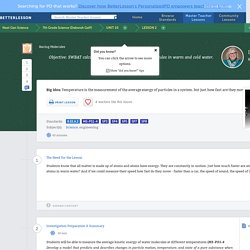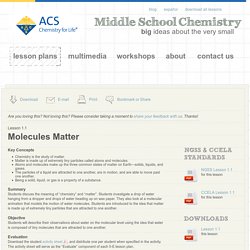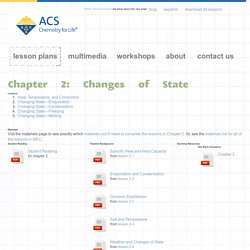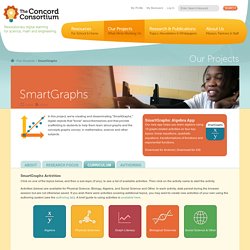

SaveThePenguinsETK. Here Comes the Sun. Heat Manual. 12heatandtemperaturemanual2008425pages175. Lesson Racing Molecules. Loading...

Racing Molecules Racing Molecules Unit 10: Thermodynamics and Heat Transfer Lesson 2 of 6 Objective: SWBAT calculate the approximate speed of molecules in warm and cold water. Deborah Gaff 83 Lessons Big Idea: Temperature is the measurement of the average energy of particles in a system. but just how fast are they moving? Print Lesson 8 teachers like this lesson Standards: Subject(s): Science, engineering 65 minutes The Need for the Lesson Students know that all matter is made up of atoms and atoms have energy. . … Read more expand content Investigation Preparation & Summary 10 min Students will be able to measure the average kinetic energy of water molecules at different temperatures (MS-PS1-4 Develop a model that predicts and describes changes in particle motion, temperature, and state of a pure substance when thermal energy is added or removed.) Resources (1) Resources (1) Racing Molecules Material List Resources Students in Action 45 min Developing a Conceptual Understanding: Beyond Memorization.
Chapter 1: Matter—Solids, Liquids, and Gases. Note: Some solids, liquids, and gases are made of atoms, and some are made of molecules.

Since the concepts covered in Chapter 1 apply to both atoms and molecules, the term “particle” is used as a generic term to include both. At this point, it is enough to give students simple working definitions of “atom” and “molecule.” You can tell students that an atom is the smallest building block of matter and that a molecule is two or more atoms connected together.
Let students know that even though atoms and molecules are different, in Chapter 1 and Chapter 2, they will both be represented by circles or spheres. Chapter 3 and Chapter 4 will go into more depth about the structure of atoms and molecules and will use more detailed models to represent them. Have a discussion about chemistry and matter. Water Drops Unite Teacher Preparation Print two “Water Drops Unite” sheets for each group.Procedure Tape a piece of wax paper over the “Water Drops Unite!” WORD to PDF Converter - go4convert.com - SaveThePenguinsETK.pdf. Middle School Chemistry Unit. Skip Navigation Middle School Chemistry big ideas about the very small Lessons Materials Vist the materials page to see exactly which materials you'll need to complete the lessons in Chapter 2.

Teaching Resources Student Reading Student Reading for chapter 2 Teacher Background Test Bank Questions. 12 heat and temperature manual 2008 4 25 pages 1 75. Energy Transfer via Solar Ovens Lessons. Passive Solar Design: Zero-Energy Housing NGSS. Teacher Information Passive solar design is the utilization of the sun's energy, the geographical climate, and the properties of different materials to heat and cool buildings.

It includes a variety of methods that use no human-made energy to operate and can reduce the amount of energy needed for heating and cooling by considerable amounts. In years past, indigenous people who lived in harsh desert locations built partially-underground homes that kept them cool during the day and warm at night. They also built adobe homes in cliff-side caves that were chosen because the winter sun warmed them and the summer sun couldn't reach them. Passive solar should not be confused with active solar design or photovoltaic solar cells. Below are examples of how some materials you provide your students might be used: The “During the Day” test represents the presence of sunshine on a clear day, by shining the bright light on the model homes. Note on Instructional Sequence. Concord Consortium. In the fall of 2011, SmartGraphs conducted a randomized experimental trial in 29 Pennsylvania schools.

In 14 schools, 17 experimental teachers used SmartGraphs activities with 49 8th and 9th grade Physical Science classes studying the motion of objects (such as position-time and velocity-time graphs). In the other 15 schools, 18 control teachers taught the same topic using the same textbooks, with 42 Physical Science classes.
This study sought to answer two research questions. A summary of findings is provided below. In October 2013 the Journal of Science Education and Technology published an article about our research on its website; for additional information besides the summary, see the accepted manuscript, Helping Students Make Sense of Graphs: An Experimental Trial of SmartGraphs Software. Gain Scores from Pre to Post Test Answers to both research questions were positive, which is encouraging. Download Free Science Activities, Access Chemistry Multimedia, Find Information on Workshops.